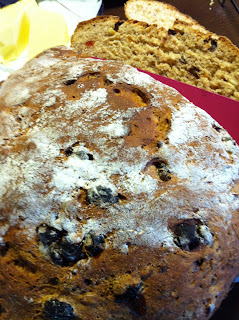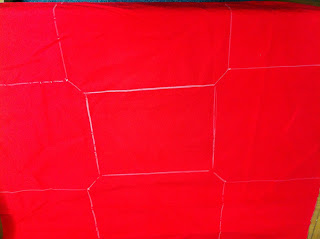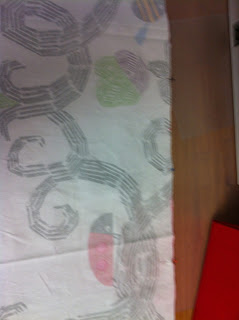 |
| thats what the bubbles on a ripe SD look like |
My first 3 attempts of sourdough died before the first 10-day-step was over. I mainly blame the very hot summer last year, and my kitchen basically had a room temperature of 32C and more as we don't have A/C. But just in case I started steralising my utensiles (see below).
With todays experience I think I would recommend to either find a cooler room ( maybe you have a cellar?) or to wait until the weather changes if you face the same problem. Using the fridge is dodgy as you will not get the right bacteria started. The lactobacilli you want to grow prefer a temperature of 25-27C. Once you have established a stable culture you can slow their growth down in the fridge to keep your dough longer, but I don´t see how you can use the fridge to grow an entire culture!
There are also a few things you can do to help your dough to start:
Number One is Hygiene. The fork and the Tupper you want to use should be rinsed with boiling water first. Also a lid if that is what you want to use! You only have to do this when you get a SD started, once you have a stable culture you can just pull a tub and fork out of the cupboard because it is a lot more forgiving.
Generally change your container every other day and later every second time you use it.
Lid or no lid? Reading a lot about SD I now know that the bread baking community seems to be split in those that use one and those that don't! Well my first 3 attempts were without one, ever since, I use one. My Mom uses just a towel on her gluten free one. So just do what works best for you and never mind what others say. Both have proofed to work for us!
The water quality is also very important. If your water has added chlorine, I would recommend using a filter! When using one of those water filters you should make sure they are not older then 4 weeks, as they too grow bacterias.
In one of the discussions I read, that your sourdough also thrives on the germs you have in the air (coexisting with your Lactos). Which could be true, as I can see my dough change a lot when we travel! The best ever SD I had when we stayed in Tønder/Denmark! But it could also have just something to do with the quality of the water and flour used... while in Denmark we had water from a well which seemed untreated.
Smell your dough before using it, if it smells off or has any type of growth...well toss it and start again!
Once you have a stable culture I recommend to freeze about 70-100gr of it, in case you kill your little friend for what ever reason, you have a fallback and don´t have to start the whole process again. Getting a frozen culture started to the point where you can skip the yeast as an ingredient takes about 2-3 days and not ten!
So this is what you need to get started:
Day 1:
50 gr flour
2 tbsp natural yoghurt
50 gr water
stir well with fork
Day 2 add:
100 gr flour
80ml water
stir well with fork
(you want a dough that will form and is not too liquidy. So if it seems to dry add water if it flows off your spoon add flour)
I hope you can see, what kind of consistency you are aiming for in these pictures.
Day 3 add:
see Day 2
Day 4:
you can take out 200 gr of your dough and either use it (but add some yeast when baking with it) or toss it. I prefer the use it part!
then add your
100 gr flour
80ml water
stir well with fork
Day 5-10:
see Day 4
Day 11:
today is the first day I would see if you can bake without adding yeast! I find sourdough needs a lot longer to rise then yeast, so best is to let it rest over night and bake in the morning.
From now on you can feed your SD roughly every 4-5 days and after 12-24h in a warmer location store it in fridge, and just use as needed.
I still bake a good bit with yeast, mainly in combination with sourdough. As I usually am in a hurry and have not got the time to let a dough sit for hours. In these cases I see the SD more as a natural preservative. As the bread baked with it, will not dry out as fast, as one just baked with yeast. But there are a few recipes I will show you in other posts like Breads and bread rolls that need no yeast what so ever, rise beautifully and you let them sit over night, and just shove them into a preheated oven in the morning and voila amazing breakfast to have!
Ok so now we have established the basics here are some recipes to look forward to:
breads in all variations, wheat and or rye bread sticks, Brack and other fruit breads (one of my favorites is a cranberry-pecan-nut-bread) SD-Pancakes and SD-Pizzadough and and and....








































